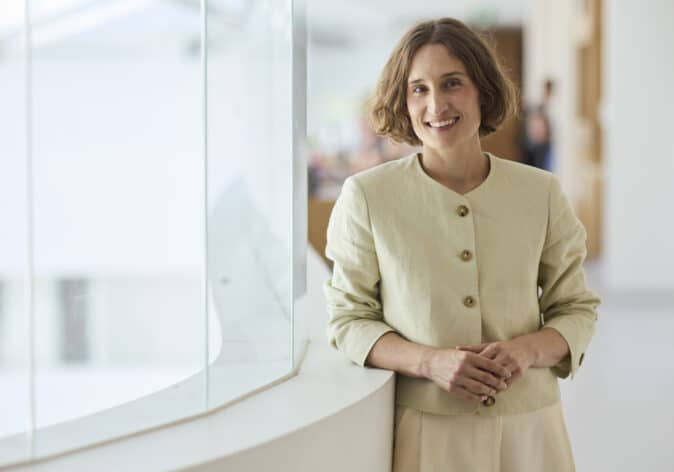Antibody drug conjugates or ADCs are a breakthrough in targeted chemotherapy for metastatic breast cancer. While ADCs like Trastuzumab Deruxtecan, also known as T-DXd, offer new hope for patients, challenges like resistance and various side effects remain and can therefore limit their clinical use.
Dr Michelle Li is a 2025 clinical fellow with Breast Cancer Trials, and her project is looking at identifying mechanisms and biomarkers of resistance to ADCs in the treatment of metastatic breast cancer.
“ADCs have rapidly emerged as a highly effective strategy to treat different subtypes of metastatic breast cancer, particularly in comparison to traditional chemotherapy. So, ADCs consist of three components. First, there’s a monoclonal antibody that targets a tumour associated androgen, like a honing missile going towards a particular base.”
“Then secondly, there’s a cytotoxic payload or what we traditionally think of as chemotherapy. And finally, there’s the linker, which connects the two. I describe it to my patients as ‘Trojan Horse’ chemotherapy.”
“So, the ADCs go right up to the cancer cells, they sneak through the front door, and then they release the chemotherapy once they’re inside to provide maximum targeted damage.”
“Because of its targeted mechanism of action, we can see from the building evidence that ADCs are performing much better than traditional chemotherapy in many settings. And so, we’re trying to bring it earlier into the treatment sequence for our patients with metastatic breast cancer. One ADC that most people might be familiar with or have heard about is Trastuzumab Deruxtecan or T-DXd.”
“And this is an ADC targeted at the HER2-receptor, and it’s been approved for use in Australia for treatment of not only HER2-positive, but also HER2-low metastatic breast cancer. Based on the pivotal results of the DESTINY-Breast04 and DESTINY-Breast03 clinical trials.”
“In quite exciting news, in September of last year, the results of the DESTINY-Breast06 study came out, which showed that for patients with chemotherapy-naive hormone-receptor-positive of HER2-low, or HER2-ultra low metastatic breast cancer, who had progressed on first line endocrine therapy, T-DXd did better than physician’s choice of chemotherapy, particularly in terms of progression-free survival, and the overall survival data is equally awaited.”
“The presence of HER2 on cells acts like a door for our ‘Trojan Horse’ to enter the cancer cell. Traditionally, we’ve thought of cancers as HER2-positive or HER2-negative. However, being HER2-negative doesn’t mean that there’s no HER2-staining of the cell at all. It just means that there’s less of it.”
“So as long as there is staining, so what we refer to as HER2-low or HER2-ultra low, then HER2-negative patients can still benefit from HER2-targeted treatments, as well as of course the HER2-positive patients.”
Listen to the Podcast
Dr Michelle Li is a 2025 clinical fellow with Breast Cancer Trials, and her project is looking at identifying mechanisms and biomarkers of resistance to ADCs in the treatment of metastatic breast cancer.
What are the key mechanisms of resistance to ADCs and how do they impact patient outcomes?
“So, we are very lucky to have access to more than just one ADC for metastatic breast cancer on the Pharmaceutical Benefits Scheme or PBS here in Australia, T-DXd as mentioned earlier, and something else called sacituzumab govitecan or ‘SG’ for patients with triple-negative breast cancer who are also HER2-low.”
“A question we often face in the clinical setting is, which ADC to give first and which ADC to give second. We know that there are emerging mechanisms of resistance. Real world evidence has shown reduced progression-free survival, so reduced efficacy of both ADCs when given sequentially after one another, which is of course disappointing when patients can’t benefit from the full effect of the second ADC, and research is being done into the key mechanisms of resistance.”
“We don’t know what exactly these are yet, but this is a question we were looking to throughout this research project.”
“Work is still ongoing in this field. One theory is that there may be some alterations in the antigen or the ‘door’ to cancer cells after exposure to the first ADC, which makes it more difficult for the second ADC to work the same way.”
What are the most significant real-world toxicities associated with ADCs and how do they differ from clinical trials data?
“On paper, the results from the clinical trials comparing ADCs traditional chemotherapy are practice changing. And certainly, in my own practice I have seen excellent results. However, real world toxicities can be significant, and these can often limit our ability to keep giving it to our patients.”
“So sometimes this means we must stop giving it early due to toxicities and switch to the next treatment. Meaning these patients miss out from getting maximal benefit from these drugs.”
“Ones that I see most commonly in my practice, would be nausea, vomiting, and cachexia or weight loss. It’s interesting because some patients will do just fine and some will do quite terribly with these side effects and require the use of lots of different types of anti-nausea medications.”
“And sometimes that’s not even enough. And so, one thing that we are doing in this clinical fellowship is looking for potential biomarkers such as something called Growth Differentiation Factor-15 or ‘GDF-15’, which might predict those patients that will have these symptoms and see whether we could intervene a bit earlier.”
“One of the other significant real-world toxicities of T-DXd is ILD, so interstitial lung disease, also known as pneumonitis. And this is inflammation of the lungs. This can result in a cough, shortness of breath, and in rare or more serious scenarios, it can cause respiratory distress or death. We saw a small but significant number of patients who experienced this in the early DESTINY-Breast studies. However, as time has gone by, we’ve become more familiar with the drug and we’re getting a lot better at monitoring for this and also managing this.”
“So, outcomes are improving, but of course, this is still something to look out for. So, in the next decade, I’m actually very excited to see where ADCs will go. I think we will see ADCs being brought into the first line setting, particularly for HER2-positive, metastatic breast cancer. And right now, a lot of focus is in the metastatic setting, but I think we’ll see it also being brought into the adjuvant setting.”
“After patients have had curative surgery for their early breast cancer, and in combination with other treatment management strategies such as endocrine therapy for hormone-receptor-positive breast cancer patients; I also think we will see other exciting combinations come through.”
“For example, there are currently trials underway combining ADCs with immunotherapy, particularly in the triple-negative metastatic breast cancer setting, and possibly a combination with other targeted agents as well, such as PARP inhibitors.”
“There are many emerging ADCs in development with other novel targets. So, I’ve talked about HER2 with T-DXd, but there are also other targets that are coming through such as HER3, or Nectin-4B. And some of this is based on inspiration that we’re getting from our other oncology colleagues from other tumor streams.”
“It’s going be invaluable to work with some of the most innovative minds in the field. The next steps in my research project are, of course, number one, getting over there. But number two, setting up some international research protocols. And number three, collecting and examining data from some large pre-existing breast cancer registries at Dana-Farber.”
What are the next steps in your research and how might international collaboration contribute to advancing this field?
“Oncology is a global specialty, and international collaboration is vital to making advances in treating breast cancer. Dana-Farber is one of the world’s leading cancer research institutes and is forging the way with research into not only targeted treatments such as ADCs, but also has led practice-changing research into supportive management and improving quality of life.”
What are your hopes for the future of breast cancer research in this space?
“I hope that many of the drugs that we give will be as effective as possible in not only holding the disease where it is, but even improving the disease burden. I think that cure is something obviously that we’re trying to aim for at all times, and you know, that’s the ultimate goal that breast cancer is going to be curable for patients.”
“I think that managing quality of life is going to be important and managing any of the symptoms that come from our treatment, because if the treatment is effective, that’s great, but you’re going to have to be able to have a decent quality of life while you’re undergoing treatment for this, so that you can spend meaningful time with your loved ones.”



